Max Dearly (1874-1943) was a French character actor, famous for his parts in French film classics of the 1930s. However, Dearly was above all an excellent actor in vaudeville and revues.

French postcard by F.C. & Cie, no. 283. Photo: Boyer & Bert. Max Dearly and Mistinguett. Collection: Didier Hanson.
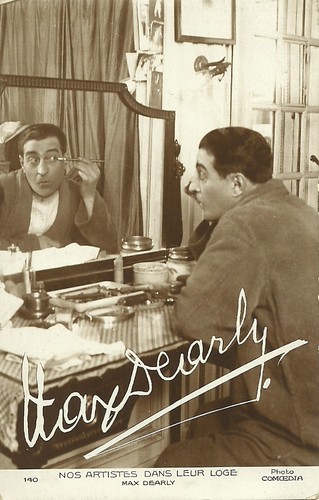
French postcard by Editions La Fayette, Paris, in the series Nos artistes dans leur loge, no. 140. Photo: Comoedia.
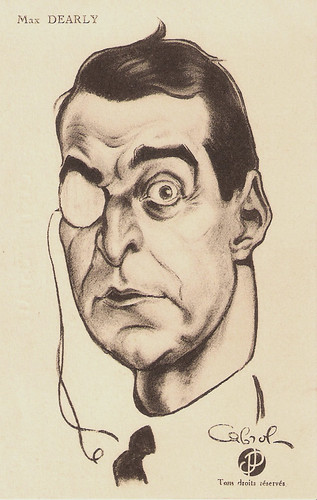
French postcard by Publications J.P., Paris, no. 7. Illustration: Cabrol.
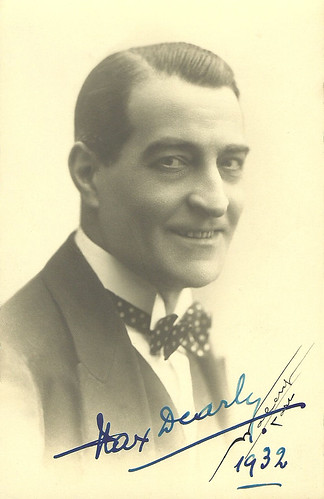
French postcard. Signed in 1932. Collection: Didier Hanson.
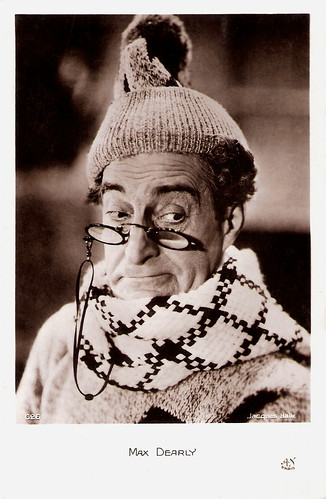
French postcard by A.N., Paris, no. 626. Photo: Jacques Haik.
Max Dearly was born Lucien Paul Marie-Joseph Rolland in Paris in 1874. He made his stage debut in 1891. Between ca. 1903 and the outbreak of the First World War, Max Dearly excelled at the Théâtre des Variétés in vaudeville and revues by Paul Gavault ('Paris aux Variétés', 1903; 'La Revue du centenaire', 1907), Robert de Flers et Gaston Arman de Caillavet, Paul Gavault ('Miquette et sa mère', 1906; 'Le Roi', 1908; 'Le Bois sacré', 1910), Alfred Capus ('Un ange', 1910; 'Les Favorites', 1911) and others. Around 1906 Dearly performed at the Moulin Rouge with the famous singer and dancer Mistinguett in a revue called 'La valse chaloupe' (The Swinging, Swaying Waltz), in which Parisian low-life and the worlds of the ‘apaches’ was performed. Postcards but also work by the Dutch painter Kees van Dongen still testify to this.
After the First World War, Dearly alternated his work at the Théâtre des Variétés with other Parisian theatres such as Théâtre de Paris, Théâtre des Nouveautés, Théâtre du Palais-Royal, Théâtre Edouard VII, and Théâtre Antoine. Popular was 'L'École des cocottes' by Paul Armont and Marcel Gerbidon, in which Dearly had the lead both in 1920 and 1923, opposite later famous film actors like Raimu and Arletty.
At his death in 1943, Léo Marchès wrote a posthumous tribute to Max Dearly for the newspaper Le Matin. Dearly was the last of the big band of the still existing Théâtre des Variétés, which between 1892 and 1914 attracted the whole of Paris, under the guidance of Fernand Samuel, 'Samuel the Magnificent'. At the boulevard Montmartre, Samuel had gathered a group that excelled both in comedy and operetta, e.g. Jeanne Gruat, Eve Lavallière, Lender, Dupuis, Albert Brasseur, Guy Gallois and his wife Germaine Gallois, Diéterle, and Max Dearly.
Dearly was an important player in this gang. Words were attributed to him that did not always originate from his performances, while he also invented adventures which people loved. Marchès claimed that Dearly's marriage with actress Jane Saint-Bonnet, also part of the troupe of Variétés, was a model of fidelity. This contrasts with Dearly’s previous reputation as a womaniser, which was the cause of the break-up with his first wife, Isabelle-Eugénie Fusier, daughter of drama actor Léon Fusier, whom he married in 1911. She was 18, he 37. Already in February 1912, the marriage ended in divorce, as Dearly had to recognise his infidelities. He was sentenced to pay his ex 800 francs per month.
When analysing comedy acting in France, literary and theatre critic Jules Lemaître wrote that three actors were absolutely outstanding, as they were able even unprepared to let the audience have peals of laughter because of their imagination and fantasy: Albert Brasseur, Galipaux et Max Dearly. About the same time, renowned stagewright Robert de Flers, claimed that Dearly was not just successful because of the plays De Flers and Caillavet had written: “It is his Dearly himself, you’ll notice it when seeing him act opposite others.”
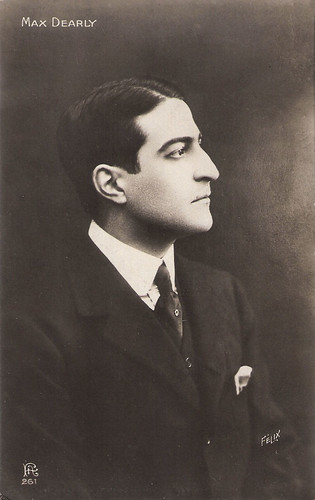
French postcard by F.A., Paris, no. 261. Photo: Félix.
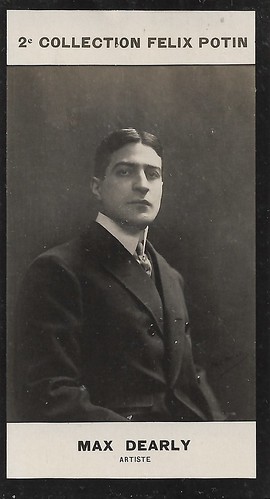
French collectors card (minicard) by Chocolat Félix Potin, Second Series, 1908. Photo: Paul Berger. Caption: Max Dearly, artiste.

French postcard by Etablissements photographiques de Boulogne-sur-Seine. Photo: H. Manuel. Max Dearly and Mistinguett. Caption: Casino de Paris.
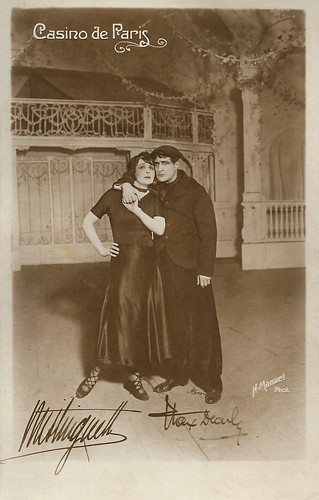
French postcard by Etablissements photographiques de Boulogne-sur-Seine. Photo: H. Manuel, Paris. Max Dearly and Mistinguett. Caption: Casino de Paris.

French postcard by Cautin et Berger, Paris. Caption: Variétés.
Before 1910, Max Dearly already acted in Film d’art films such as L’Empreinte (Henri Burguet, 1908) and Carmen (André Calmettes, 1908). He had his real breakthrough as a film actor with the arrival of sound cinema in France. His first part was in Azaïs (René Hervil, 1931), an adaptation of a play by Louis Verneuil and Georges Berr in which Dearly had performed in 1930 at the Théâtre Edouard VII. Director René Hervil was a routiné of the silent French cinema, who had mainly done comedy but also drama. After that followed leads in Coquecigrole (André Berthomieu, 1931), the film operetta Coups de roullis (Pierre de la Cour, 1932), and L’Amour et la veine (Monty Banks, 1932) – the French language version of Money for Nothing.
In 1933 Dearly played the pharmacist Homais in Jean Renoir’s adaptation of Gustave Flaubert’s Madame Bovary. Memorable was also his part as the eccentric aristocrat Mr. Gillenormand, Marius’ grandfather in Les Misérables (Raymond Bernard, 1934). Dearly acted opposite Harry Baur as Jean Valjean, Jean Servais as Marius and Josseline Gael as Cosette.
Dearly was hilarious as Mr Banco in René Clair’s Le Dernier Milliardaire/The Last Billionaire (1934). Banco is the richest man on earth, who basically becomes the dictator of Casinario, a fictional small European kingdom which is on the verge of going broke. While losing reason after a knock on the head, he orders the stupidest decretes which the people and elite of Casinario still accept as common sense. After Arlette et ses papas (Henry Roussel, 1934), Dearly played M. Maubert opposite Fernand Gravey and Mireille Balin in Richard Pottier’s Si j'étais le patron (1934). In 1935 he had the lead in Pottier’s Un oiseau rare, based on a novel by Erich Kästner, 'Three Men in the Snow', and scripted by Jacques Prévert. It is a comedy of changing trades between a master and a valet and winning a winter sports holiday. It co-starred Pierre Brasseur, Monique Rolland and Pierre Larquey.
After Paris Camargue (Jack Forrester 1935), Dearly had again the lead as Ramiro Mendoza in La Vie Parisienne/Parisian Life (1936) by German émigré director Robert Siodmak a. It was scripted by Marcel Carné, Michel Carré, Emeric Pressburger and Benno Vigny and adapted from the operetta by Ludovic Halévy and Henri Meilhac. Dearly played a Brazilian businessman who opposes his daughter’s (Conchita Montenegro) marriage to a Parisian (Georges Rigaud). His father and a former operetta diva with whom he had had an affair in the past, convert him to ‘Parisian Life’. A separate English-language version was also produced. The film was not a success, causing financial problems for the production company, Nero Film, run by the émigré producer Seymour Nebenzal.
Then, Dearly played Blanchette Brunoy’s neglecting father in the comedy Claudine à l’école (Serge de Poligny, 1937), after Colette. After other secondary parts as in Le Train pour Venise (André Berthomieu, 1938) starring Louis Verneuil on whose play the film was based. Dearly had again a lead in Christian-Jaque’s Le Grand Élan (1939), about a real estate owner who wants to buy a bankrupt hotel for a low price. The film was released in Paris in December 1940, when the city was already occupied by the Nazis. In the meantime Dearly had also acted in Sacha Guitry’s comedy Ils étaient neuf célibataires/Nine Bachelors (1939) in which foreign women threatened to be exiled from marries for fake with old clochards. His last, supporting parts in film, Dearly played in Bécassine (Pierre Caron, 1940) and Le Club des soupirants (Maurice Gleize, 1941). Max Dearly died in Neuilly-sur-Seine in 1943 and lies buried at the cemetery of Montparnasse. Dearly was responsible for the foundation of the Gala de l'Union des Artistes, founded in 1923 to help artists in trouble.

French postcard. Photo: Paul Boyer / Ruck. Caption: Qu'est-ce qu'il y a dans mon verre? Du Vin Désiles, parbleu!!! (What's that in my glass? Its is Désiles wine, parbleu!!!).
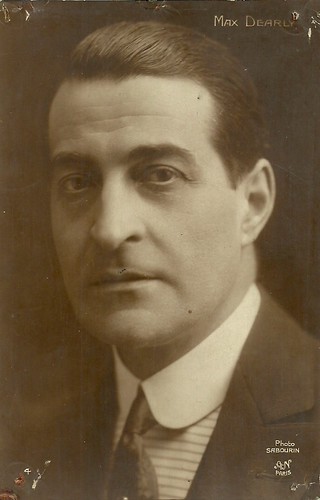
French postcard by A.N., Paris, no. 4. Photo: Sabourin.
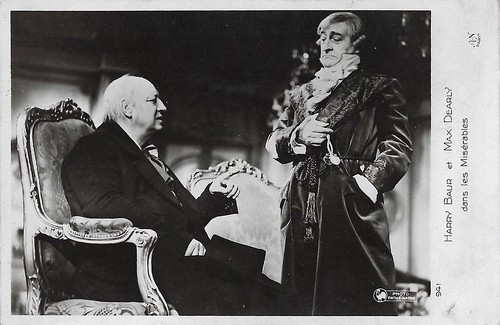
French postcard by A.N. Paris, no. 941. Photo Pathé Natan. Harry Baur as Jean Valjean and Max Dearly as Gillenormand in Les Misérables (Raymond Bernard, 1934).
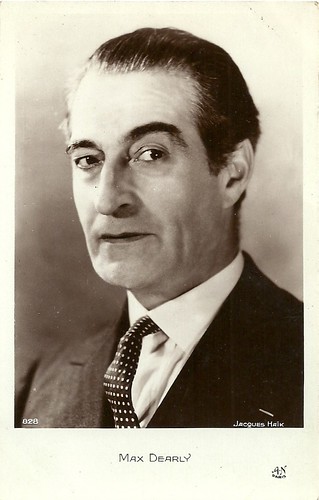
French postcard by A.N. Paris, no. 828. Photo: Jacques Haïk.
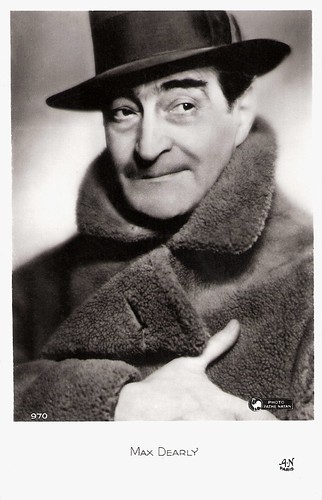
French postcard by A.N., Paris, no. 970. Photo: Pathé Natan.
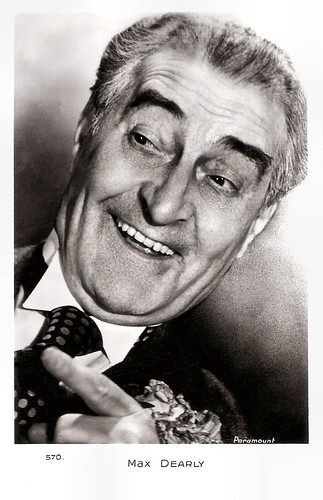
French postcard by Editions Chantal, Paris, no. 570. Photo: Paramount.
Sources: Léo Marchès (Hommage posthume à Max Dearly, Le Matin, 9 June 1943 - French), Du temps des cerises aux feuilles mortes (French), Wikipedia (French and English) and IMDb.
This post was last updated on 8 December 2023.

French postcard by F.C. & Cie, no. 283. Photo: Boyer & Bert. Max Dearly and Mistinguett. Collection: Didier Hanson.

French postcard by Editions La Fayette, Paris, in the series Nos artistes dans leur loge, no. 140. Photo: Comoedia.

French postcard by Publications J.P., Paris, no. 7. Illustration: Cabrol.

French postcard. Signed in 1932. Collection: Didier Hanson.

French postcard by A.N., Paris, no. 626. Photo: Jacques Haik.
Letting the audience have peals of laughter
Max Dearly was born Lucien Paul Marie-Joseph Rolland in Paris in 1874. He made his stage debut in 1891. Between ca. 1903 and the outbreak of the First World War, Max Dearly excelled at the Théâtre des Variétés in vaudeville and revues by Paul Gavault ('Paris aux Variétés', 1903; 'La Revue du centenaire', 1907), Robert de Flers et Gaston Arman de Caillavet, Paul Gavault ('Miquette et sa mère', 1906; 'Le Roi', 1908; 'Le Bois sacré', 1910), Alfred Capus ('Un ange', 1910; 'Les Favorites', 1911) and others. Around 1906 Dearly performed at the Moulin Rouge with the famous singer and dancer Mistinguett in a revue called 'La valse chaloupe' (The Swinging, Swaying Waltz), in which Parisian low-life and the worlds of the ‘apaches’ was performed. Postcards but also work by the Dutch painter Kees van Dongen still testify to this.
After the First World War, Dearly alternated his work at the Théâtre des Variétés with other Parisian theatres such as Théâtre de Paris, Théâtre des Nouveautés, Théâtre du Palais-Royal, Théâtre Edouard VII, and Théâtre Antoine. Popular was 'L'École des cocottes' by Paul Armont and Marcel Gerbidon, in which Dearly had the lead both in 1920 and 1923, opposite later famous film actors like Raimu and Arletty.
At his death in 1943, Léo Marchès wrote a posthumous tribute to Max Dearly for the newspaper Le Matin. Dearly was the last of the big band of the still existing Théâtre des Variétés, which between 1892 and 1914 attracted the whole of Paris, under the guidance of Fernand Samuel, 'Samuel the Magnificent'. At the boulevard Montmartre, Samuel had gathered a group that excelled both in comedy and operetta, e.g. Jeanne Gruat, Eve Lavallière, Lender, Dupuis, Albert Brasseur, Guy Gallois and his wife Germaine Gallois, Diéterle, and Max Dearly.
Dearly was an important player in this gang. Words were attributed to him that did not always originate from his performances, while he also invented adventures which people loved. Marchès claimed that Dearly's marriage with actress Jane Saint-Bonnet, also part of the troupe of Variétés, was a model of fidelity. This contrasts with Dearly’s previous reputation as a womaniser, which was the cause of the break-up with his first wife, Isabelle-Eugénie Fusier, daughter of drama actor Léon Fusier, whom he married in 1911. She was 18, he 37. Already in February 1912, the marriage ended in divorce, as Dearly had to recognise his infidelities. He was sentenced to pay his ex 800 francs per month.
When analysing comedy acting in France, literary and theatre critic Jules Lemaître wrote that three actors were absolutely outstanding, as they were able even unprepared to let the audience have peals of laughter because of their imagination and fantasy: Albert Brasseur, Galipaux et Max Dearly. About the same time, renowned stagewright Robert de Flers, claimed that Dearly was not just successful because of the plays De Flers and Caillavet had written: “It is his Dearly himself, you’ll notice it when seeing him act opposite others.”

French postcard by F.A., Paris, no. 261. Photo: Félix.

French collectors card (minicard) by Chocolat Félix Potin, Second Series, 1908. Photo: Paul Berger. Caption: Max Dearly, artiste.

French postcard by Etablissements photographiques de Boulogne-sur-Seine. Photo: H. Manuel. Max Dearly and Mistinguett. Caption: Casino de Paris.

French postcard by Etablissements photographiques de Boulogne-sur-Seine. Photo: H. Manuel, Paris. Max Dearly and Mistinguett. Caption: Casino de Paris.

French postcard by Cautin et Berger, Paris. Caption: Variétés.
The richest man on earth
Before 1910, Max Dearly already acted in Film d’art films such as L’Empreinte (Henri Burguet, 1908) and Carmen (André Calmettes, 1908). He had his real breakthrough as a film actor with the arrival of sound cinema in France. His first part was in Azaïs (René Hervil, 1931), an adaptation of a play by Louis Verneuil and Georges Berr in which Dearly had performed in 1930 at the Théâtre Edouard VII. Director René Hervil was a routiné of the silent French cinema, who had mainly done comedy but also drama. After that followed leads in Coquecigrole (André Berthomieu, 1931), the film operetta Coups de roullis (Pierre de la Cour, 1932), and L’Amour et la veine (Monty Banks, 1932) – the French language version of Money for Nothing.
In 1933 Dearly played the pharmacist Homais in Jean Renoir’s adaptation of Gustave Flaubert’s Madame Bovary. Memorable was also his part as the eccentric aristocrat Mr. Gillenormand, Marius’ grandfather in Les Misérables (Raymond Bernard, 1934). Dearly acted opposite Harry Baur as Jean Valjean, Jean Servais as Marius and Josseline Gael as Cosette.
Dearly was hilarious as Mr Banco in René Clair’s Le Dernier Milliardaire/The Last Billionaire (1934). Banco is the richest man on earth, who basically becomes the dictator of Casinario, a fictional small European kingdom which is on the verge of going broke. While losing reason after a knock on the head, he orders the stupidest decretes which the people and elite of Casinario still accept as common sense. After Arlette et ses papas (Henry Roussel, 1934), Dearly played M. Maubert opposite Fernand Gravey and Mireille Balin in Richard Pottier’s Si j'étais le patron (1934). In 1935 he had the lead in Pottier’s Un oiseau rare, based on a novel by Erich Kästner, 'Three Men in the Snow', and scripted by Jacques Prévert. It is a comedy of changing trades between a master and a valet and winning a winter sports holiday. It co-starred Pierre Brasseur, Monique Rolland and Pierre Larquey.
After Paris Camargue (Jack Forrester 1935), Dearly had again the lead as Ramiro Mendoza in La Vie Parisienne/Parisian Life (1936) by German émigré director Robert Siodmak a. It was scripted by Marcel Carné, Michel Carré, Emeric Pressburger and Benno Vigny and adapted from the operetta by Ludovic Halévy and Henri Meilhac. Dearly played a Brazilian businessman who opposes his daughter’s (Conchita Montenegro) marriage to a Parisian (Georges Rigaud). His father and a former operetta diva with whom he had had an affair in the past, convert him to ‘Parisian Life’. A separate English-language version was also produced. The film was not a success, causing financial problems for the production company, Nero Film, run by the émigré producer Seymour Nebenzal.
Then, Dearly played Blanchette Brunoy’s neglecting father in the comedy Claudine à l’école (Serge de Poligny, 1937), after Colette. After other secondary parts as in Le Train pour Venise (André Berthomieu, 1938) starring Louis Verneuil on whose play the film was based. Dearly had again a lead in Christian-Jaque’s Le Grand Élan (1939), about a real estate owner who wants to buy a bankrupt hotel for a low price. The film was released in Paris in December 1940, when the city was already occupied by the Nazis. In the meantime Dearly had also acted in Sacha Guitry’s comedy Ils étaient neuf célibataires/Nine Bachelors (1939) in which foreign women threatened to be exiled from marries for fake with old clochards. His last, supporting parts in film, Dearly played in Bécassine (Pierre Caron, 1940) and Le Club des soupirants (Maurice Gleize, 1941). Max Dearly died in Neuilly-sur-Seine in 1943 and lies buried at the cemetery of Montparnasse. Dearly was responsible for the foundation of the Gala de l'Union des Artistes, founded in 1923 to help artists in trouble.

French postcard. Photo: Paul Boyer / Ruck. Caption: Qu'est-ce qu'il y a dans mon verre? Du Vin Désiles, parbleu!!! (What's that in my glass? Its is Désiles wine, parbleu!!!).

French postcard by A.N., Paris, no. 4. Photo: Sabourin.

French postcard by A.N. Paris, no. 941. Photo Pathé Natan. Harry Baur as Jean Valjean and Max Dearly as Gillenormand in Les Misérables (Raymond Bernard, 1934).

French postcard by A.N. Paris, no. 828. Photo: Jacques Haïk.

French postcard by A.N., Paris, no. 970. Photo: Pathé Natan.

French postcard by Editions Chantal, Paris, no. 570. Photo: Paramount.
Sources: Léo Marchès (Hommage posthume à Max Dearly, Le Matin, 9 June 1943 - French), Du temps des cerises aux feuilles mortes (French), Wikipedia (French and English) and IMDb.
This post was last updated on 8 December 2023.
No comments:
Post a Comment